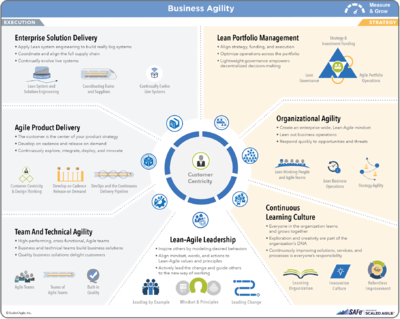Difference between revisions of "Business Agility"
| Line 5: | Line 5: | ||
*Continuously be at a competitive advantage | *Continuously be at a competitive advantage | ||
Business agility is concerned with the adoption and evolution of values, behaviors and capabilities. These enable businesses and individuals to be more adaptive, creative and resilient when dealing with complexity, uncertainty and change leading to improved well-being and better outcomes.<ref>Definition - What Does Business agility Mean?</ref> | Business agility is concerned with the adoption and evolution of values, behaviors and capabilities. These enable businesses and individuals to be more adaptive, creative and resilient when dealing with complexity, uncertainty and change leading to improved well-being and better outcomes.<ref>Definition - What Does Business agility Mean?</ref> | ||
| + | |||
| + | |||
| + | __TOC__ | ||
| + | |||
| + | |||
| + | == Definition of Business Agility == | ||
| + | [[Scaled Agile Framework (SAFe®)|SAFE®]] defines Business Agility as: “The ability to compete and succeed in the digital age by responding quickly to market changes and opportunities with innovative business solutions. It requires that all those involved in providing solutions – business and technology leaders, development, IT operations, law, marketing, finance, support, compliance, security and others – apply lean and agile procedures to continuous Providing innovative, quality products and services faster than the competition."<ref>What is Business Agility? [https://www.pedco.eu/business-agility-in-safe-5-0/ Pedco]</ref> | ||
| + | |||
| + | |||
| + | [[File:Business Agility.png|400px|Business Agility.png]]<br /> | ||
| + | source: Pedco | ||
| + | |||
| + | |||
| + | It is important to remember, Business Agility happens when the entire organization—business and tech leaders, compliance, development, finance, legal, marketing, operations, sales, security, support—use Lean and Agile practices to continually and proactively deliver innovative business solutions faster than the competition. | ||
Revision as of 16:22, 3 October 2021
Business Agility is the ability of an organization to:
- Adapt quickly to market changes - internally and externally
- Respond rapidly and flexibly to customer demands
- Adapt and lead change in a productive and cost-effective way without compromising quality
- Continuously be at a competitive advantage
Business agility is concerned with the adoption and evolution of values, behaviors and capabilities. These enable businesses and individuals to be more adaptive, creative and resilient when dealing with complexity, uncertainty and change leading to improved well-being and better outcomes.[1]
Definition of Business Agility
SAFE® defines Business Agility as: “The ability to compete and succeed in the digital age by responding quickly to market changes and opportunities with innovative business solutions. It requires that all those involved in providing solutions – business and technology leaders, development, IT operations, law, marketing, finance, support, compliance, security and others – apply lean and agile procedures to continuous Providing innovative, quality products and services faster than the competition."[2]
It is important to remember, Business Agility happens when the entire organization—business and tech leaders, compliance, development, finance, legal, marketing, operations, sales, security, support—use Lean and Agile practices to continually and proactively deliver innovative business solutions faster than the competition.
Benefits of and Risks of Business Agility[3]
Benefits of Business Agility
- Challenge management. Organizations adopting business agility can easily react and respond to opportunities and threats in the marketplace while remaining customer-centric. Freed of long-term plans and strategies, these organizations can adapt to situations much faster than their more bureaucratic counterparts.
- Competitive advantage. Agile businesses can seize upon short-term opportunities, giving them the ability to be a first mover. They can learn from their mistakes and setbacks, readjust trajectories quickly and not remain committed to their plans. And they can confidently react proactively to keep pace with (or outpace) the competition.
- Cross-functional collaboration. Business agility can also break down organizational silos and foster creativity and innovative problem-solving thanks to the cross-pollination of ideas and supportive environment. But decentralized decision making comes with its own share of drawbacks.
Risks of Business Agility
- Short-term solutions. Agility sometimes sacrifices long-term competitiveness. This can create disadvantages versus organizations that have invested in new technologies and strategies that require a longer development cycle. If an organization is solely in read-and-react mode, it’s difficult to define, build, and bring to market completely new solutions.
- Lack of innovation. There is a high risk of different parts of the organization reinventing the wheel, duplicating efforts or creating conflicting versus complementary solutions. The larger the organization, the harder it is to effectively implement business agility at scale.
- ↑ Definition - What Does Business agility Mean?
- ↑ What is Business Agility? Pedco
- ↑ What are the Benefits of and Risks of Business Agility? Product Plan

